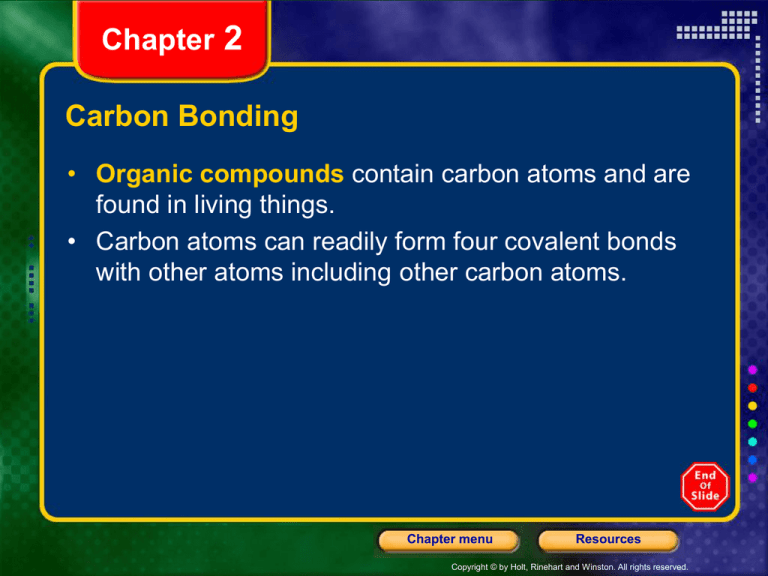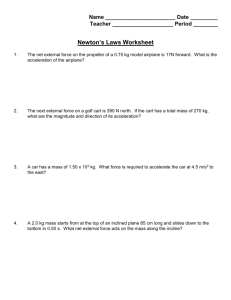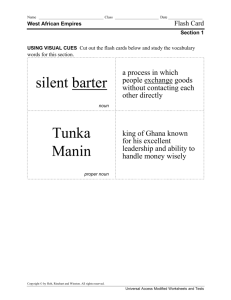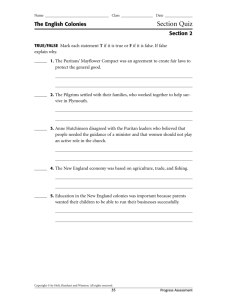
Chapter 2
Carbon Bonding
• Organic compounds contain carbon atoms and are
found in living things.
• Carbon atoms can readily form four covalent bonds
with other atoms including other carbon atoms.
Chapter menu
Resources
Copyright © by Holt, Rinehart and Winston. All rights reserved.
Chapter 2
Carbon Bonding
Chapter menu
Resources
Copyright © by Holt, Rinehart and Winston. All rights reserved.
Chapter 2
Functional Groups
• Functional groups are groups of atoms that
influence the properties of molecules and the
chemical reactions in which the molecules
participate.
Chapter menu
Resources
Copyright © by Holt, Rinehart and Winston. All rights reserved.
Chapter 2
Carbon Molecules
• Condensation reactions join monomers (small
simple molecules) to form polymers. A condensation
reaction releases water as a by-product.
• In a hydrolysis reaction, water is used to split
polymers into monomers.
Chapter menu
Resources
Copyright © by Holt, Rinehart and Winston. All rights reserved.
Chapter 2
Carbohydrates
• organic compounds composed of carbon, hydrogen,
and oxygen
• ratio of one carbon to two hydrogen atoms to one
oxygen atom
• source of energy
• used as structural materials in organisms
• Molecule #1 shown
Chapter menu
Resources
Copyright © by Holt, Rinehart and Winston. All rights reserved.
Chapter 2
Carbohydrates
Chapter menu
Resources
Copyright © by Holt, Rinehart and Winston. All rights reserved.
Chapter 2
Carbohydrates
• Monosaccharides
– Carbohydrates are made up of monomers called
monosaccharides.
• Disaccharides and Polysaccharides
– Two monosaccharides join to form a double sugar
called a disaccharide.
– A complex sugar, or polysaccharide, is made of
three or more monosaccharides.
Chapter menu
Resources
Copyright © by Holt, Rinehart and Winston. All rights reserved.
Chapter 2
Disaccharides
Chapter menu
Resources
Copyright © by Holt, Rinehart and Winston. All rights reserved.
Chapter 2
Proteins
• composed mainly of carbon, hydrogen, oxygen, and
nitrogen.
• have many functions including structural, defensive,
and catalytic roles.
Chapter menu
Resources
Copyright © by Holt, Rinehart and Winston. All rights reserved.
Chapter 2
Proteins
• Amino Acids
– Proteins are made up of monomers called amino
acids.
– The sequence of amino acids determines a
protein’s shape and function.
Chapter menu
Resources
Copyright © by Holt, Rinehart and Winston. All rights reserved.
Chapter 2
Amino Acid
Chapter menu
Resources
Copyright © by Holt, Rinehart and Winston. All rights reserved.
Chapter 2
Proteins
• Dipeptides and Polypeptides
– Two amino acids are joined by peptide bonds to
form a dipeptide.
– A long chain of amino acids is called a
polypeptide.
Chapter menu
Resources
Copyright © by Holt, Rinehart and Winston. All rights reserved.
Chapter 2
Structure of Proteins
Chapter menu
Resources
Copyright © by Holt, Rinehart and Winston. All rights reserved.
Chapter 2
Lipids
•
•
•
•
•
•
Carbon, hydrogen, and oxygen chains
nonpolar molecules
store energy
function in insulation
important part of cell membranes
Molecule #2 shown
Chapter menu
Resources
Copyright © by Holt, Rinehart and Winston. All rights reserved.
Chapter 2
Fats
Chapter menu
Resources
Copyright © by Holt, Rinehart and Winston. All rights reserved.
Chapter 2
Lipids
• Fatty Acids
– Most lipids contain fatty acids, unbranched
carbon molecules that have a hydrophilic end and
a hydrophobic end.
Chapter menu
Resources
Copyright © by Holt, Rinehart and Winston. All rights reserved.
Chapter 2
Fatty Acids
Chapter menu
Resources
Copyright © by Holt, Rinehart and Winston. All rights reserved.
Chapter 2
Lipids
• Triglycerides
– Triglycerides consist of three fatty acids and one
molecule of glycerol.
• Phospholipids
– Phospholipids, which make up cell membranes,
consist of two fatty acids and one glycerol
molecule.
Chapter menu
Resources
Copyright © by Holt, Rinehart and Winston. All rights reserved.
Chapter 2
Lipids
• Waxes
– made of one long fatty acid chain joined to one
long alcohol
• Steroids
– composed of four fused carbon rings
Chapter menu
Resources
Copyright © by Holt, Rinehart and Winston. All rights reserved.
Chapter 2
Nucleic Acids
• large and complex organic molecule
• stores and transports information
• The nucleic acid deoxyribonucleic acid (DNA)
contains genetic information for cell activities.
• Ribonucleic acid (RNA) molecules play many key
roles in building of proteins and can act as enzymes.
Chapter menu
Resources
Copyright © by Holt, Rinehart and Winston. All rights reserved.
Chapter 2
Structure of Nucleic Acids
Chapter menu
Resources
Copyright © by Holt, Rinehart and Winston. All rights reserved.
Chapter 2
Nucleic Acids
Chapter menu
Resources
Copyright © by Holt, Rinehart and Winston. All rights reserved.
Chapter 2
Energy and Matter
• States of Matter
– Addition of energy
to a substance
can cause its
state to change
from a solid to a
liquid and from a
liquid to a gas.
– Kinetic energy
decreases as
temperature
decreases
Chapter menu
Resources
Copyright © by Holt, Rinehart and Winston. All rights reserved.
Chapter 2
Energy and Chemical Reactions
• Reactants are substances that enter chemical
reactions.
• Products are substances produced by chemical
reactions.
Chapter menu
Resources
Copyright © by Holt, Rinehart and Winston. All rights reserved.
Chapter 2
Energy and Chemical Reactions
Chapter menu
Resources
Copyright © by Holt, Rinehart and Winston. All rights reserved.
Chapter 2
Energy and Chemical Reactions, continued
• Activation Energy
– Enzymes lower the amount of activation
energy (shown as b) necessary for a reaction
to begin in living systems.
Chapter menu
Resources
Copyright © by Holt, Rinehart and Winston. All rights reserved.
Chapter 2
Energy and Chemical Reactions, continued
• Oxidation Reduction Reactions
– A chemical reaction in which electrons are
exchanged between atoms is called an
oxidation-reduction reaction.
Chapter menu
Resources
Copyright © by Holt, Rinehart and Winston. All rights reserved.
Chapter 2
• Enzymes (Catalyst)
– Proteins that catalyze (speed up) chemical
reactions
– bind to specific substrates at the Active Site
– The binding of a substrate with an enzyme causes
– a change in the enzyme’s shape
– lowering of the activation energy
Chapter menu
Resources
Copyright © by Holt, Rinehart and Winston. All rights reserved.
Chapter 2
Enzyme Activity
Chapter menu
Resources
Copyright © by Holt, Rinehart and Winston. All rights reserved.
Standardized Test Prep
Multiple Choice
1. Which of the following is not a function of
polysaccharides?
A. energy source
B. energy storage
C. structural support
D. storage of genetic information
Chapter menu
Resources
Copyright © by Holt, Rinehart and Winston. All rights reserved.
Standardized Test Prep
Multiple Choice, continued
1. Which of the following is not a function of
polysaccharides?
A. energy source
B. energy storage
C. structural support
D. storage of genetic information
Chapter menu
Resources
Copyright © by Holt, Rinehart and Winston. All rights reserved.
Standardized Test Prep
Multiple Choice, continued
2. Which of the following statements is false?
F. A wax is a lipid.
G. Starch is a lipid.
H. Saturated fats are solid at room temperature.
J. Unsaturated fats are liquid at room temperature.
Chapter menu
Resources
Copyright © by Holt, Rinehart and Winston. All rights reserved.
Standardized Test Prep
Multiple Choice, continued
2. Which of the following statements is false?
F. A wax is a lipid.
G. Starch is a lipid.
H. Saturated fats are solid at room temperature.
J. Unsaturated fats are liquid at room temperature.
Chapter menu
Resources
Copyright © by Holt, Rinehart and Winston. All rights reserved.
Standardized Test Prep
Multiple Choice, continued
3. Which of the following molecules stores hereditary
information?
A. ATP
B. DNA
C. protein
D. carbohydrates
Chapter menu
Resources
Copyright © by Holt, Rinehart and Winston. All rights reserved.
Standardized Test Prep
Multiple Choice, continued
3. Which of the following molecules stores hereditary
information?
A. ATP
B. DNA
C. protein
D. carbohydrates
Chapter menu
Resources
Copyright © by Holt, Rinehart and Winston. All rights reserved.
Standardized Test Prep
Multiple Choice, continued
4. What is the name of the molecule in plants that
stores sugars?
F. starch
G. protein
H. cellulose
J. glycogen
Chapter menu
Resources
Copyright © by Holt, Rinehart and Winston. All rights reserved.
Standardized Test Prep
Multiple Choice, continued
4. What is the name of the molecule in plants that
stores sugars?
F. starch
G. protein
H. cellulose
J. glycogen
Chapter menu
Resources
Copyright © by Holt, Rinehart and Winston. All rights reserved.
Standardized Test Prep
Multiple Choice, continued
The figure below illustrates
the basic structure of a cell
membrane. Use the
figure to answer the questions
that follow.
5. Which of the following
molecules make up the
basic structure of a cell
membrane?
A. waxes
B. steroids
C. fatty acids
D. phospholipids
Chapter menu
Resources
Copyright © by Holt, Rinehart and Winston. All rights reserved.
Standardized Test Prep
Multiple Choice, continued
The figure below illustrates
the basic structure of a cell
membrane. Use the
figure to answer the questions
that follow.
5. Which of the following
molecules make up the
basic structure of a cell
membrane?
A. waxes
B. steroids
C. fatty acids
D. phospholipids
Chapter menu
Resources
Copyright © by Holt, Rinehart and Winston. All rights reserved.
Standardized Test Prep
Multiple Choice, continued
The figure below illustrates
the basic structure of a cell
membrane. Use the
figure to answer the questions
that follow.
6. The “tails” of the molecules
in the figure orient away
from water. Which of the
following describes the
tail’s movement away from
water?
F. polar
G. adhesive
H. hydrophilic
J. hydrophobic
Chapter menu
Resources
Copyright © by Holt, Rinehart and Winston. All rights reserved.
Standardized Test Prep
Multiple Choice, continued
The figure below illustrates
the basic structure of a cell
membrane. Use the
figure to answer the questions
that follow.
6. The “tails” of the molecules
in the figure orient away
from water. Which of the
following describes the
tail’s movement away from
water?
F. polar
G. adhesive
H. hydrophilic
J. hydrophobic
Chapter menu
Resources
Copyright © by Holt, Rinehart and Winston. All rights reserved.
Standardized Test Prep
Multiple Choice, continued
7. simple sugars : carbohydrates :: amino acids :
A. lipids
B. proteins
C. nucleic acids
D. amino acids
Chapter menu
Resources
Copyright © by Holt, Rinehart and Winston. All rights reserved.
Standardized Test Prep
Multiple Choice, continued
7. simple sugars : carbohydrates :: amino acids :
A. lipids
B. proteins
C. nucleic acids
D. amino acids
Chapter menu
Resources
Copyright © by Holt, Rinehart and Winston. All rights reserved.
Standardized Test Prep
Multiple Choice, continued
The figure below represents
the structural formula of a
molecule. Use the
figure to answer the question
that follows.
8. What is the name of the
functional group circled in the
structural formula?
F. amino
G. hydroxyl
H. phosphate
J. carboxyl
Chapter menu
Resources
Copyright © by Holt, Rinehart and Winston. All rights reserved.
Standardized Test Prep
Multiple Choice, continued
The figure below represents
the structural formula of a
molecule. Use the
figure to answer the question
that follows.
8. What is the name of the
functional group circled in the
structural formula?
F. amino
G. hydroxyl
H. phosphate
J. carboxyl
Chapter menu
Resources
Copyright © by Holt, Rinehart and Winston. All rights reserved.
Standardized Test Prep
Short Response
Proteins are affected by environmental conditions
such as heat and pH.
Explain why the process of cooking an egg cannot be
reversed.
Chapter menu
Resources
Copyright © by Holt, Rinehart and Winston. All rights reserved.
Standardized Test Prep
Short Response, continued
Proteins are affected by environmental conditions
such as heat and pH.
Explain why the process of cooking an egg cannot be
reversed.
Answer:
The heat that is added to the egg changes the bonds
in the proteins and other molecules that make up the
egg to such a large extent that the original protein
shape can no longer be distinguished.
Chapter menu
Resources
Copyright © by Holt, Rinehart and Winston. All rights reserved.
Standardized Test Prep
Extended Response
Enzymes are essential for the functioning of all cells.
Part A Explain what enzymes do that is essential for
cell function.
Part B Explain the induced fit model of enzyme
action.
Chapter menu
Resources
Copyright © by Holt, Rinehart and Winston. All rights reserved.
Standardized Test Prep
Extended Response, continued
Answer:
Part A Enzymes catalyze chemical reactions that are
involved in important cell processes.
Part B Bonding of the substrates to enzymes causes a
slight change in the enzyme’s shape, thereby
weakening some of the bonds and lowering activation
energy.
Chapter menu
Resources
Copyright © by Holt, Rinehart and Winston. All rights reserved.
Section 1 Carbon Compounds
Energy Currency
Chapter menu
Resources
Copyright © by Holt, Rinehart and Winston. All rights reserved.









